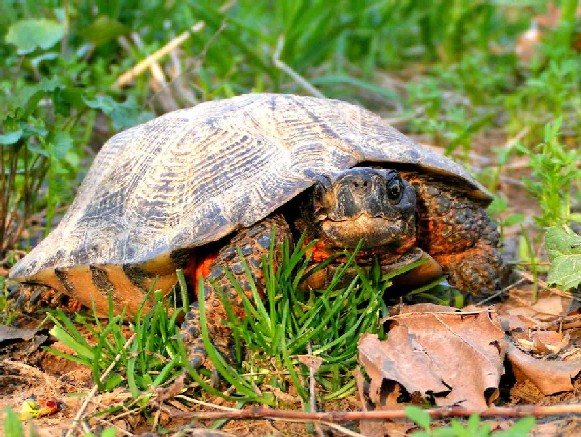|
| Query: Rough ray | Result: 6th of 20 | |
Wood Turtle (Glyptemys insculpta) - Wiki
| Subject: | Wood Turtle (Glyptemys insculpta) - Wiki
| |

| Resolution: 581x437
File Size: 121474 Bytes
Upload Date: 2007:10:19 17:05:31
|
Wood Turtle
From Wikipedia, the free encyclopedia
[Photo] Wood Turtle (Glyptemys insculpta). Previously known as Clemmys insculpta. Source: USGS, http://nas.er.usgs.gov/queries/FactSheet.asp?speciesID=1234
The Wood Turtle (Glyptemys insculpta) is one of two species in the genus Glyptemys, both of which are limited to North America. Until 2002, the Wood Turtle was placed in the genus Clemmys but genetic analyses revealed that the Wood Turtle and Bog Turtle formed a distinct group. The Wood Turtle reaches carapace lengths of 6 to 9 inches. The wood turtle is accurately named, and spends most of its time in wooded areas. It is, however, also semi-aquatic and dependent on streams, rivers, and ponds. There are two apparent phenotypes. An orange 'redlegs' morph with a yellow ringed iris (generally) and a Yellow 'yellowlegs' morph with a solid black iris Schnirel, (1985). Color variations: The different color aspect of this species has been mentioned by Pope, (1938) and Harding, (1997). The Yellow legs phenotype seems to hail from the western part of the range.
http://en.wikipedia.org/wiki/Wood_Turtle
| The text in this page is based on the copyrighted Wikipedia article shown in above URL. It is used under the GNU Free Documentation License. You may redistribute it, verbatim or modified, providing that you comply with the terms of the GFDL. |
|
Comments |
|---|
| | Guest |
|
Wood turtle (Glyptemys insculpta)
Previously known as: Clemmys insculpta, Testudo insculpta and Emys speciosa
The wood turtle probably derives both its Latin and common names from the deep concentric growth rings and grooves known as ‘annuli' that mark the somewhat raised carapacial scutes, which give the shell a ‘sculpted' appearance as if carved from wood. In immature specimens (up to the age of 15 or even up to 20), roughly one ring is produced per year so that the annuli count can give a rough estimate of age, usually accurate within a couple of years. Once they approach adulthood, however, accuracy drops off quickly. The back edge of the carapace is serrated and a prominent keel runs down the centre, also adding to its sculpted appearance. The carapace is typically brown or greyish-brown, sometimes with ray-like yellow streaking. The upper head is usually black, and upperparts of the limbs and tail are grey to greyish-brown, or even black with yellow spots. By contrast, the vividly-coloured underparts range from yellow in specimens from western (Great Lakes) parts of the species' range, to orangish-yellow or orange in the central part of its range, to orange-red or ‘salmon-red' in the northeast. Hatchling turtles have flat, non-sculpted, almost circular carapaces, and lack any of the adult yellow, orange or red pigment. The yellow plastron is also distinctive, with its pattern of dark blotches along the outside edge of each scute. |
| | cialis |
|
| fg4g9r oncjgmya uxhqsems uipqfxtk |
| | prix cialis pfizer |
|
| rrbbrbkz qpnowvfw dtbudngq |
^o^
Animal Pictures Archive for smart phones
^o^
|
|
|